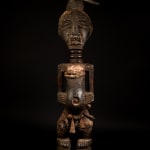Songye Figure, 19th - 20th century
Wood
height 126 cm
height 49 5/8 in
height 49 5/8 in
MA.231
Further images
The human appearance and visible attributes of chieftaincy of the nkisi are juxtaposed with the more animal characteristics emphasising his non-human ‘otherness’. A partially concealed large animal horn, presumably filled...
The human appearance and visible attributes of chieftaincy of the nkisi are juxtaposed with the more animal characteristics emphasising his non-human ‘otherness’. A partially concealed large animal horn, presumably filled with medicinal matter, reinforces the figure’s wild power. The nkisi rests his hands on his stomach, where traditionally it was believed the most important part of a human being, the living spirit, resides. The face has distinctive features with closed semi-circular shell-shaped eyes and large arched eyebrows, giving the face its distinctive V-shape, interrupted only by the short horizontal line of the chin. A rectangular protruding form contains two rows of gritted teeth. The head and arms show a dark and shiny patina, while the tone of the legs is closer to the wood’s natural surface. The discrepancy signals the loss of a skirt that would have originally covered the lower half of the body.
Large-scale power figures such as this example were central to the life of Songye communities spread over a vast territory in east-central Democratic Republic of the Congo. Designed to act as intercessors between ancestral spirits and the living, nkishi were intended to benefit the entire community and were not the property of a single individual. The consecration of a nkishi was a public event unifying the community; chiefs and elders commissioned the nkishi and the community was responsible for cutting the tree selected for the carving, often selected for its curative or toxic properties.
Once completed, the nkishi was displayed in a central location such as the center of the village or near the chief’s house. Alongside it would stand a guardian serving as an interpreter for the messages received through dreams. Collective tellings occurred following specific dreams or nightmares as well as during celebrations related to the appearance of the new moon, symbolising of new life, fertility, and wealth. During a new moon, the nkishi was carried in procession through the village but could not be touched due to its great potency; instead, wooden poles attached under its arms with raffia strings were used.
Large-scale power figures such as this example were central to the life of Songye communities spread over a vast territory in east-central Democratic Republic of the Congo. Designed to act as intercessors between ancestral spirits and the living, nkishi were intended to benefit the entire community and were not the property of a single individual. The consecration of a nkishi was a public event unifying the community; chiefs and elders commissioned the nkishi and the community was responsible for cutting the tree selected for the carving, often selected for its curative or toxic properties.
Once completed, the nkishi was displayed in a central location such as the center of the village or near the chief’s house. Alongside it would stand a guardian serving as an interpreter for the messages received through dreams. Collective tellings occurred following specific dreams or nightmares as well as during celebrations related to the appearance of the new moon, symbolising of new life, fertility, and wealth. During a new moon, the nkishi was carried in procession through the village but could not be touched due to its great potency; instead, wooden poles attached under its arms with raffia strings were used.







